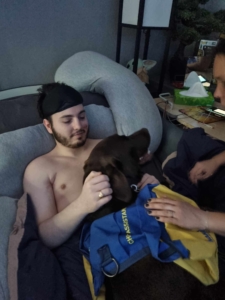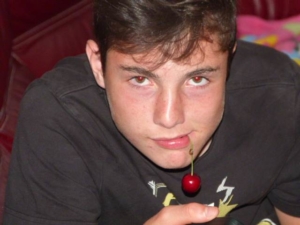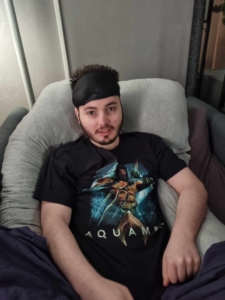Robin
February 10, 2000 – December 24, 2023 / France
Thank you to Véronique Gadomski for sharing her son’s story:
 He grew up with no health problems
He grew up with no health problems
Robin was the eldest of 4 siblings.
Like many other Lafora children, Robin grew up with no health problems. Learning, whatever it was, was no problem. He was carefree, intelligent, a go-getter, sensitive, strong-willed, loving, subtle and funny. He loved his family, sports, friends, video games, vacations, fishing, the sea, and eating – basically, living life!
Epilepsy misdiagnosis
Robin had his first seizure at the age of 12, the day after a birthday party with friends. We found him convulsing on our trampoline, an image we’ll never forget. His eyes rolled back, excessive salivation, contractions of upper and lower limbs, no reaction… we thought we’d lost him. The fire department intervened and quickly realized it was an epileptic seizure. That was the start of the countdown.
He was put on Depakene for two years to treat idiopathic epilepsy. The neurologist told us at the time that it was highly likely that it was only temporary, as the EEG trace was not worrying.
During these two years, Robin developed like a “normal” teenager. He never had another seizure, so the neurologist stopped his treatment, which we were very happy about.
Unfortunately, eight days later, while playing basketball outdoors, Robin had another seizure. He was hospitalized again, and the neurologist asked him to resume his Depakene treatment, as the EEG tracing was not favorable.
It was a hard blow for all of us. Robin accepted the situation less well. He was 14.5 years old and didn’t understand why epilepsy had invited itself into his daily life. He didn’t want to be different; he didn’t want to be marginalized, he didn’t want to see the future in terms of this “invisible” illness that would complicate his life.
Life resumed its course, with the difficulties associated with epilepsy, the treatments, and the disorders that insidiously set in. They are imperceptible at first, until they become more visible. At 17, Robin was seen by an adult neurologist. He took over his case and listened attentively. Robin told him about his tremors, which were, in fact, myoclonus.
His diagnosis was changed to juvenile myoclonic epilepsy.
The seizures soon intensified, and the cognitive and psychomotor problems became clearer. Despite the difficulties, Robin refused to accept the help he needed with his schooling and his illness. He was increasingly difficult to manage and reason with. He was short-tempered, aggressive with those around him, and often acted without a filter. At that time, Robin chose to go and live with his father for a few months.
The trusting relationship with our neurologist enabled us to make progress with his diagnosis, and he suggested we carry out a genetic test to rule out any possible progressive myoclonic epilepsy.
Over the next few months, Robin’s condition only worsened. He had more and more seizures, his walking was unsteady, he was absent, and it became difficult to have reasoned exchanges with him. His condition was extremely worrying.
Robin got his Lafora Disease diagnosis 
The results of the genetic test arrived 9 months later and told us that Robin was a carrier of Lafora Disease, a death sentence. At the age of 19, he forgot his first name, could no longer put a piece of clothing on a hanger, dress himself, or put on a seatbelt, and he suffered from seeing himself diminish in this way. He had to be taken out of school and placed under guardianship. A 24-hour supervision was necessary.
Less than a month later, when he was alone with his little brother at his father’s house, he didn’t know how to react when a fire broke out and ended up with 3rd-degree burns to both feet… Robin was then hospitalized for a month for a skin graft and suffered his first “state of prolonged epileptic seizure.” As a result, he prematurely became a wheelchair user.
Robin returned to live with us. This requires organizing with third parties, nursing staff, and structures to help us deal with the situation in the best possible way. Robin struggled to learn to walk again, despite myoclonus from Lafora and pain from his burns. He also had to cope with his father’s abandonment over the months.
But Robin is a warrior, he shows great mental strength and continues on his way.
After the COVID-19 epidemic, Robin suffered a fever worse than any previous episode and had to be hospitalized. His condition was worrying. He hardly woke up at all and had up to 30 seizures a day. We prepared for the worst. But Robin continued to fight and recovered after a few weeks of treatment. He relearned to eat and speak, and gradually regained his memories. And just two months later, he was back living at home, but not walking again.
2023
Robin is now 23 years old and has already won many battles. He has been hospitalized at home, bedridden, and under 24-hour surveillance for three years. He has difficulty with light and heat. Robin has speech, comprehension, and swallowing difficulties, but he eats by himself with our help. His cognitive and psychomotor problems are progressing as the disease progresses.
When Robin can speak, his only question to the neurologist is whether there is a drug that will cure him…
This hope of finally seeing a treatment that will make us forget the horror of Lafora grips us all, patients, parents, families, loved ones, and researchers…






